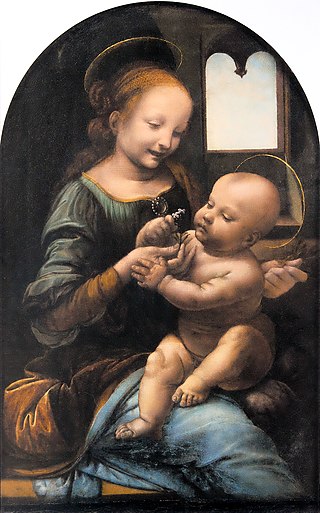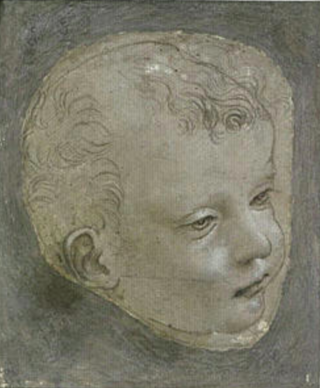Attribution
In 1930, Tancred Borenius attributed the Ashmolean version to Leonardo. [7] Though this has gone undisputed, it has not been accepted by most scholars of Leonardo.
Recent research by a consortium of Leonardo experts argues that the Moscow version is likely the origin of the composition and may contain an underdrawing by Leonardo's hand. The consortium included Alexander Kossolapov, Martin Kemp, and Thereza Wells. Kemp said of the painting:
This is the most remarkable of the narrative Madonnas, with the child reacting to the goldfinch which is held up by Saint John with him clinging onto the lamb, the sacrificial animal ... As far as attributions go it is very difficult because you've got studio production, you've got various artists of various status, you've also got later of followers ... But the Leonardo involvement in the inventione is perfectly clear. [8]
Kossolapov argued that the Moscow painting is the work by Leonardo and his workshop. [2] Kemp and Wells were more reserved and concluded there were no clear signs of Leonardo's hand in the underdrawing. They further concluded that there probably never was an 'original' painting and the Moscow and Florence versions would have been regarded as 'Leonardo's', that is, works produced in Leonardo's brand. [3]

BartolomeoMontagna was an Italian Renaissance painter who mainly worked in Vicenza. He also produced works in Venice, Verona, and Padua. He is most famous for his many Madonnas and his works are known for their soft figures and depiction of eccentric marble architecture. He is considered to be heavily influenced by Giovanni Bellini, in whose workshop he might have worked around 1470. Benedetto Montagna, a productive engraver, was his son and pupil and active until about 1540. He was mentioned in Vasari's Lives as a student of Andrea Mantegna but this is widely contested by art historians.

The Virgin of the Rocks, sometimes the Madonna of the Rocks, is the name of two paintings by the Italian Renaissance artist Leonardo da Vinci, of the same subject, with a composition which is identical except for several significant details. The version generally considered the prime version, the earlier of the two, is unrestored and hangs in the Louvre in Paris. The other, which was restored between 2008 and 2010, hangs in the National Gallery, London. The works are often known as the Louvre Virgin of the Rocks and London Virgin of the Rocks respectively. The paintings are both nearly 2 metres high and are painted in oils. Both were originally painted on wooden panels, but the Louvre version has been transferred to canvas.

The Virgin and Child with Saint Anne is an unfinished oil painting by High Renaissance artist Leonardo da Vinci, dated to c. 1501–1519. It depicts Saint Anne, her daughter the Virgin Mary and the infant Jesus. Christ is shown grappling with a sacrificial lamb symbolizing his Passion as the Virgin tries to restrain him. The painting was commissioned as the high altarpiece for the Church of Santissima Annunziata in Florence and its theme had long preoccupied Leonardo.

The Benois Madonna, otherwise known as the Madonna and Child with Flowers, is a painting by the Italian Renaissance master Leonardo da Vinci in the Hermitage Museum, Saint Petersburg. One of two Madonnas begun by Leonardo in October 1478, it was completed c. 1478–1480; the other was the Madonna of the Carnation, now in the Alte Pinakothek, Munich.

The Madonna Litta is a late 15th-century painting, by Leonardo da Vinci, in the Hermitage Museum, Saint Petersburg. It depicts the Virgin Mary breastfeeding the Christ child, a devotional subject known as the Madonna lactans. The figures are set in a dark interior with two arched openings, as in Leonardo's earlier Madonna of the Carnation, and a mountainous landscape in aerial perspective can be seen beyond. In his left hand Christ holds a goldfinch, which is symbolic of his future Passion.

The Virgin and Child with Saint Anne and Saint John the Baptist, sometimes called the Burlington House Cartoon, is a drawing by Leonardo da Vinci. The drawing is in charcoal and black and white chalk, on eight sheets of paper that are glued together. Because of its large size and format the drawing is presumed to be a cartoon for a painting. No painting by Leonardo exists that is based directly on this cartoon, although the drawing may have been in preparation for a now lost or unexecuted painting commissioned by Louis XII. The drawing is the only extant larger-scale drawing by the artist.

The Madonna of the Yarnwinder is a subject depicted by Leonardo da Vinci in at least one, and perhaps two paintings begun in 1499 or later. Leonardo was recorded as being at work on one such picture in Florence in 1501 for Florimond Robertet, a secretary to King Louis XII of France. This may have been delivered to the French court in 1507, though scholars are divided on this point. The subject is known today from several versions of which two, called the Buccleuch Madonna and the Lansdowne Madonna, are thought to be partly by Leonardo's hand. The underdrawings of both paintings show similar experimental changes made to the composition, suggesting that both evolved concurrently in Leonardo's workshop.

La Belle Jardinière, also known as the Madonna and Child with Saint John the Baptist, is a painting started by the Italian High Renaissance artist Raphael, and finished by Ridolfo del Ghirlandaio, that depicts the Madonna, a young Christ, and a young John the Baptist. It is believed to have been commissioned by the Sienese patrician Fabrizio Sergardi in approximately 1507. It is currently displayed in the Louvre Museum in Paris, France.

The Garvagh Madonna is an oil painting by the Italian Renaissance artist Raphael, dating to c. 1509–1510. It depicts the Virgin, the Christ Child and the infant John the Baptist, and is one of many paintings by Raphael with this trio. It is from early in the artist's third, or Roman period, in which distinctive changes are seen from his Umbrian or Florentine period in style and use of colour, with the introduction of more natural subjects and settings.

The Holy Infants Embracing is a painting by Leonardo da Vinci. It represents the infant Christ embracing his cousin John the Baptist. The subject matter relates to the two paintings of the Virgin of the Rocks by Leonardo and numerous other Renaissance works by Raphael and others of the meeting of the two children on the road to Egypt while escaping the Massacre of the Innocents.

Giampietrino, probably Giovanni Pietro Rizzoli, was a north Italian painter of the Lombard school and Leonardo's circle, succinctly characterized by S. J. Freedberg as an "exploiter of Leonardo's repertory."

The Madonna del Prato, formally Madonna with the Christ Child and Saint John the Baptist, is an oil on board painting by Raphael, created in 1506, now held in the Kunsthistorisches Museum in Vienna. It is also known as the Madonna del Belvedere after its long residence in the imperial collection in the Vienna Belvedere.

The Leonardeschi were the large group of artists who worked in the studio of, or under the influence of, Leonardo da Vinci. They were artists of Italian Renaissance painting, although his influence extended to many countries within Europe.

The Madonna and Child with the Infant John the Baptist is a 1518 oil-on-panel painting by the Italian painter Antonio da Correggio.

Study for the Madonna of the Cat is a set of two drawings by Leonardo da Vinci on both sides of a sheet of paper 13 centimeters high and 9.4 centimeters wide. The two drawings were made in pen and brown ink, on a preparatory drawing in stylus, with a brown wash on the back. This is one of the six works of Leonardo da Vinci showing the Virgin and Child playing with a cat or carrying it. A mirror symmetry between the drawings of the two faces is visible by transparency. The Study for the Madonna of the Cat is currently held at the British Museum in London under inventory number 1856,0621.1. The creative and scientific processes underlying the drawing Madonna of the Cat have been discussed by many art historians, including Kenneth Clark, Martin Kemp, Carmen Bambach and Larry Feinberg.

Compositional Sketches for the Virgin Adoring the Christ Child, with and without the Infant St. John the Baptist; Diagram of a Perspectival Projection (recto); Slight Doodles (verso) is a 1480s drawing by Leonardo da Vinci. It is in the collection of the Metropolitan Museum of Art.

The Virgin and Child with Saint Anne is a cartoon said to have been created by Leonardo da Vinci as part of his "Virgin and Child with Saint Anne" project, and now considered lost. It is known from a letter written on April 3, 1501, by Fra Pietro Novellara, Isabella d'Este's envoy to the painter. For this reason, it is sometimes referred to as "Fra Pietro's cartoon". Although still hypothetical, its existence seems to be confirmed by paintings by Raffaello and Andrea del Brescianino that are said to have been made from it, as well as by various pencil studies.

The Tête d'enfant de trois quarts à droite is a silverpoint drawing on paper by the Florentine painter Leonardo da Vinci. It belongs to the Codex Vallardi and is preserved at the Department of Graphic Arts of the Louvre Museum in Paris.
























